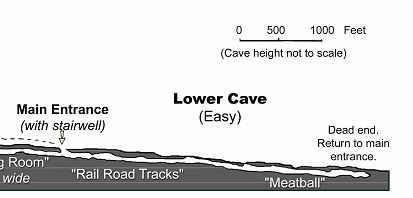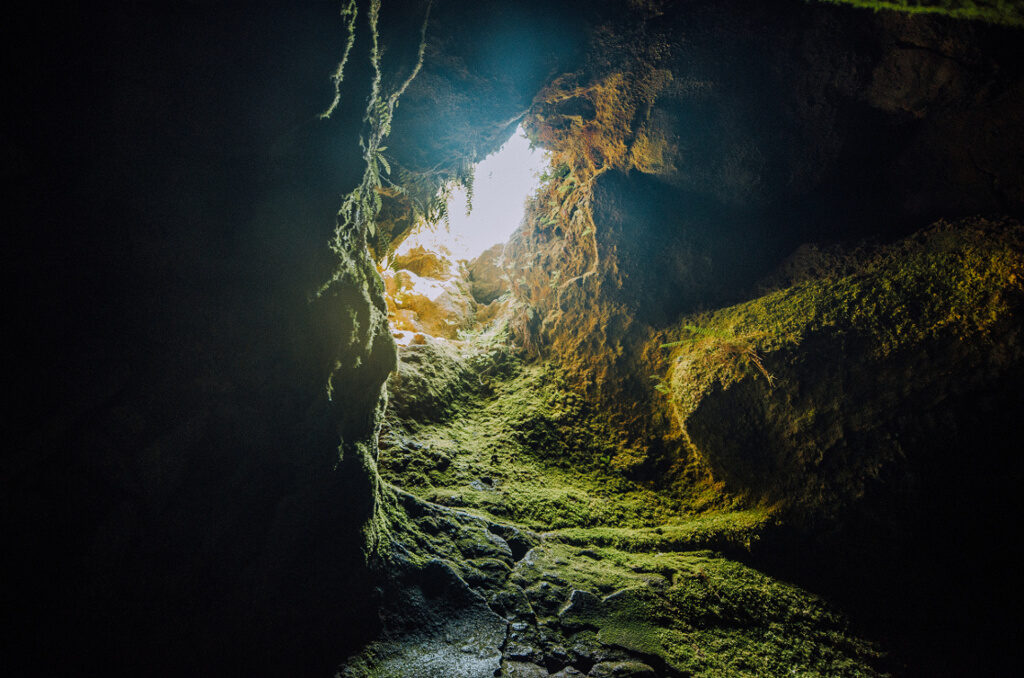What’s more fun than a barrel of monkeys (and just as dark inside)? Ape Cave! This stunning lava tube cave in Washington is open to explore year-round and is definitely worth a visit when near Mount St. Helens and Gifford Pinchot National Forest.
When I went to Washington, I had no idea this cave even existed…so I made a spur-of-the-moment decision to go inside. But there are a few things I wish I had known and prepared for before entering! This post should help you be prepared and know exactly what to expect from your time at the Ape Caves.


What is Ape Cave in Washington?
The Ape Cave lava tubes (also known as “the Ape Caves”) is the longest lava tube in the continental United States and the third longest in North America. At 13,042 feet long, it is an impressive display of volcanic power and a rare and spectacular phenomenon.
So it’s exciting, to say the least, that it is open to explore year-round! If you plan to go exploring in Ape Cave, make sure you respect this unique geological formation. It may seem hardy because it’s made of rocks…but in reality this is a delicate and fragile ecosystem that we need to care for and respect.
Why Is It Called Ape Caves?
The name “Ape Cave” might leave you wondering when there were apes roaming Washington, how the apes got there (zoo escapees maybe?), and why you’ve never heard of these mysterious Washington apes before. In reality, though, the name has nothing to do with the animals but instead refers to a local group called the St. Helens Apes.
The St. Helens Apes were a group of foresters who were sponsors for a local Scout Troop. In the early 1950’s, these scouts and their leader Harry Reese became the first people to explore this cave. Remembering their sponsors, the scouts decided to honor them by naming the cave after the St. Helens Apes.
If you’re disappointed (like I was) that you won’t run into any apes on the cave trail, let me assure you that your disappointment will be short lived when you start exploring inside the caves and see the beauty and wonder that awaits!
Where are the Ape Caves?
The Ape Caves in Washington State, USA are located in Gifford Pinchot National Forest. They’re just a short distance from Mount St Helens, so if you are already planning to be in this area it is a perfect additional stop to add to your itinerary.
If you’re looking for driving directions to the caves, this is the Ape Cave headquarters location.


Exploring Lower Ape Cave

Ape Cave is divided into two distinct halves, and during your time here you can hike one or both of them as desired.
The Lower Cave is the easier part of the lava tube to hike and is suitable for nearly all ages. Although the floor can be a bit uneven at times, no climbing is required. So whether you are young, old, or somewhere in between you can enjoy exploring this trail. Just make sure you have fairly good balance!
This section of the lava tube goes from the main entrance to a dead end and then you turn around and retrace your steps back to the stairwell. It is 3/4 mile one way and can be hiked in about an hour, although I think it is more fun if you take your time while exploring instead of just booking it there and back.
Do keep in mind that the passageway you walk through gradually gets smaller as you approach the dead end. However, you never have to crawl or even bend down unless you want to enter some of the small tunnels at the very end.
A side note for those with claustrophobia: if you have claustrophobia, you probably already know that cave exploration might not be the best idea for you…but honestly, even those with mild claustrophobia can enjoy Lower Ape Cave as it really is quite roomy throughout. My mother has claustrophobia and has frequently declined entering small, enclosed spaces across the world, but after speaking with others who explored the cave she decided to give it a try and found that Lower Ape Cave did not cause any issues for her.
Exploring Upper Ape Cave

The Upper Ape Cave is far more difficult than the easy section. As a result, it is also far more interesting! This 1.5 mile trek (one way) requires you to scramble over 27 large boulder piles scattered throughout the cave. There is rarely a clear route to take up the boulders, so you have to feel your way along and hope for the best. This section also contains an 8 foot lava fall that you must climb up to make it to the Upper Entrance/Exit.
Because of these obstacles, the upper cave takes far more time to explore and requires a healthy does of caution and agility to make it through safely.
But while this part of the cave is certainly more difficult than the lower cave, one of the aspects that makes the upper cave so worth exploring is the skylight near the Upper Entrance/Exit. This skylight contrasts so spectacularly with the darkness of the cave, and after feeling your way over boulders and rock piles it is quite the sensation to stumble upon a light shining down through the ceiling!
After you make it past the skylight in the Upper Cave, you only have several more rock piles to scamper over and then you’ll find yourself at the ladder exit. (This is a very appropriate time to mull over Plato’s Allegory of the Cave from The Republic as you prepare to ascend into the sunlight! Freedom! Light! Knowledge! See the physical world for the illusion that it is!)
Alternatively, just freak out a bit if you aren’t a fan of ladders and have often been known to cry while trying to ascend/descend the ladder into your attic. Ahem. I’m not scared of heights. Not at all.


After climbing the ladder, you emerge back on the surface and breathe in the fresh air. Hopefully, you’ll start to get feeling back into your numb and cold fingers.
Once you’ve explored both sides of the cave and experienced their magnitude, it seems strange to think that such enormous formations like this lava tube went undiscovered for so long. But when you exit the upper entrance and start to hike away, make sure you turn and take a look back.
Even when you are standing literally right above the cave entrance you basically can’t see it at all. If you didn’t know the entrance was there, I’d wager the most likely way you’d find it is by falling down the hole and breaking a leg. No wonder it was undiscovered for so long!
After you’ve finished the 1.5 mile trek of the Upper Ape Cave from under the ground, the route directs you back to the main entrance via an above-ground trail that takes approximately 45-60 minutes to hike. It’s good to follow this route rather than returning by the underground trail, as taking the above ground trail back means you don’t have to jump down an 8 foot lava wall and possibly break a few bones in the process!
If you have the mobility and agility, I highly recommend exploring the upper cave as it is a much more exciting and demanding experience. However, if all you can explore is the lower cave, it is still amazing to experience this unique ecosystem!

What to Know about Ape Caves
Ape Caves hours are year-round during daylight, so pretty much anytime you are in the area is a good time to go! It’s always cold in the caves and the temperature usually hovers about the same whether it is winter or summer.
There are bathroom facilities at the parking lot…but obviously there are no bathroom facilities in the caves, so keep this in mind before you start exploring underground.
There is no entrance fee for ape cave, but you will have to pay for parking at the Ape Cave lot. If you have a Northwest Forest Pass or America the Beautiful Pass you can use this to park for free, otherwise it costs $5 for the day (note that in winter you will need a Sno-Park pass instead to park in this area).
What to Bring With You to Explore
There are several items you’ll want to consider bringing with you for practical purposes. Here are the items you’ll need:
- Flashlight: Caves are dark, so you will need a quality light to find your way. Headlamps like this one will give you the most flexibility and are especially nice if you decide to hike the upper cave as you will have your hands free for climbing the lava wall and climbing over the boulder piles. Flashlights like this one also work well, but cell phone flashlights are not recommended as they are not reliable or strong enough. In a pinch, you can rent a gas lantern at the visitor area for $5, but it is nicer to have your own light source. Make sure you have a main light source plus a backup source, as the caves are in total darkness and if your light gives out you’ll be stuck.
- Long pants: The caves are COLD, even in summer. I cannot stress this enough. You’ll want long pants to keep you warm, but long pants are also a good idea to protect your legs if you plan to explore the upper cave because you’ll be scrambling over rocks and rocky surfaces.
- Jacket: Just like you’ll want long pants, you’ll also want a jacket for the caves even in summer. I wore a sweatshirt I had with me because it was all I had (remember, my cave excursion was a spur-of-the-moment, oh-hey-there’s-a-cave-let’s-go-explore-it experience). If I had known I was going cave exploring, I would have wanted to bring a waterproof or water repellent jacket because the cave ceiling is drippy and likes to send water down on your head and person.
- Gloves: Your hands will get very cold in the cave, unless you have gloves, shove your hands in your pockets, or are using a gas lantern as your light source. I recommend just coming prepared with gloves so your hands will stay warm instead of going numb!
- Hand warmer: For those who are adverse to cold or who have health issues like Raynaud’s that mean your hands get cold easier, it’s a good idea to have a hand warmer on hand. This is the one I use, and it’s rechargeable which is even better!
What NOT to Bring to Ape Cave
Here are a few things not to bring with you and not to do in Ape Cave. Remember that this cave is a fragile ecosystem, so we want to be careful and respectful while exploring.
Here are some things that are not permitted in Ape Cave:
- Food
- Alcohol
- Pets
- Fireworks
- Fires
- Smoking
- Rock collecting
Essentially, if it could damage the cave or the creatures inside in any way, use your common sense and don’t bring or use it!
There is also a big issue in caves around the world right now called white nose syndrome, so please take a few minutes to educate yourself about this issue and the risk it poses to the bats in Ape Caves, Washington. If you know a little about it, you can better prepare yourself so you don’t help spread this highly infectious disease across North America. We want to keep those little bats as the brown-nosers they’re supposed to be!
Is Ape Cave on your list to see while road tripping Washington or the PNW? Check out this article about everything you need for the perfect road trip!
Save for Later

